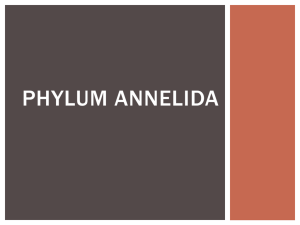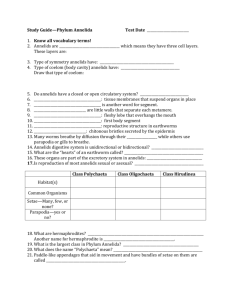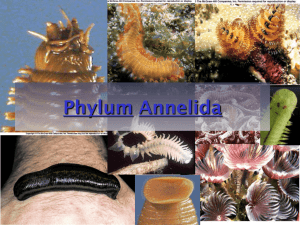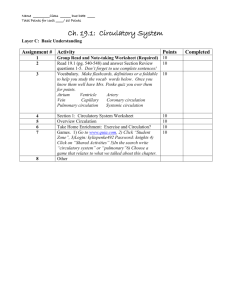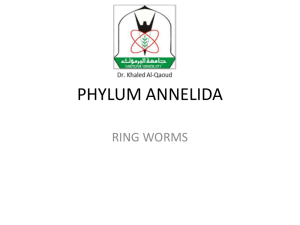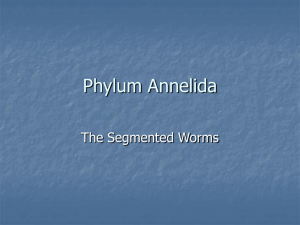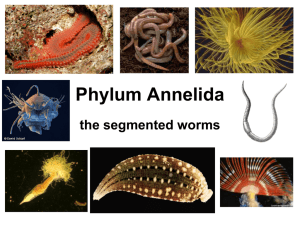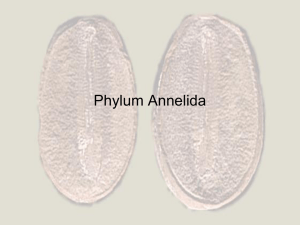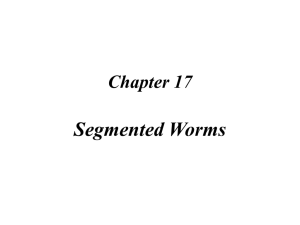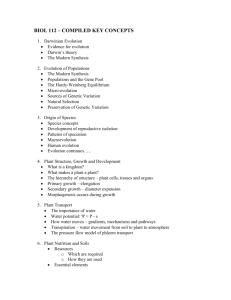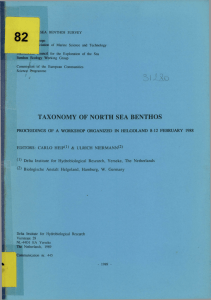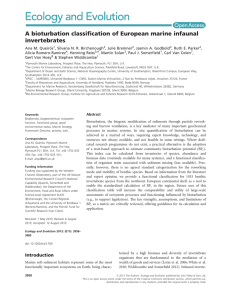PowerPoint 15: Annelida 2
advertisement
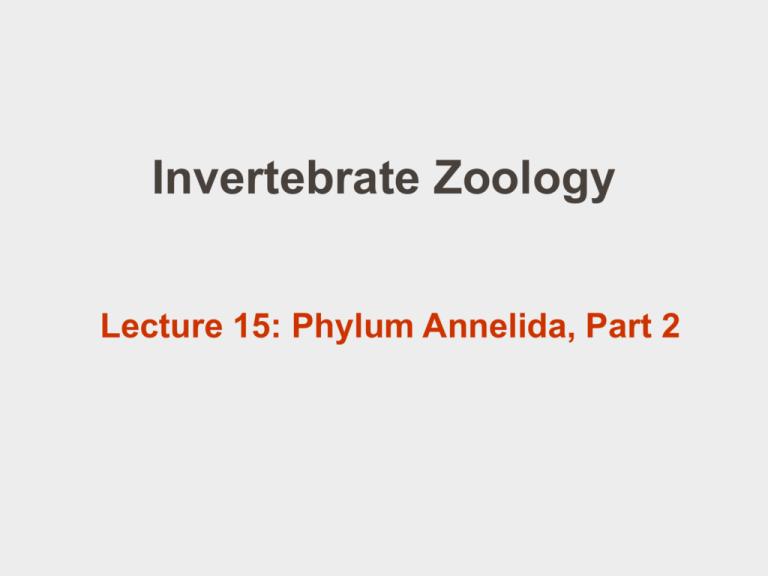
Invertebrate Zoology Lecture 15: Phylum Annelida, Part 2 Lecture outline Phylum Annelida, Part 2 Circulation/gas exchange Osmoregulation/excretion Nervous system/Sensory structures Class Polychaeta Class Clitellata next time… Circulation/gas exchange: Overview Why do members of Phylum Annelida need a circulatory system? Circulation/gas exchange: Class Polychaeta Closed circulatory system Key gas exchange sites Parapodia Additional structures (some) Anterior gills (Terebellidae) Tentacular crown (Sabellidae) Body surface If no other structures Circulation/gas exchange: Class Polychaeta Two major vessels Dorsal: blood anteriorly Ventral: blood posteriorly Extensive capillary beds in Parapodia Other gas exchange structures Anterior and posterior Intestine Blood moves between main vessels via Capillary beds Segmental vessels (=ring vessel) Circulation/gas exchange: Class Polychaeta Circulation/gas exchange: Class Polychaeta No hearts Movement of blood via vessel contraction & body wall contraction Respiratory pigments Primarily dissolved within plasma Primarily hemoglobin Two forms of hemoglobin for polychaetes in potentially low-oxygen environments How do these two forms differ? Adaptive value? Circulation/gas exchange: Class Polychaeta Terrebellidae circulatory system Circulation/gas exchange: Class Clitellata, Subclass Oligochaeta Closed circulatory system Organization similar to Polychaeta Key differences include Subneural vessel (so 3 main vessels) More highly-developed pumping structures Large, muscular dorsal vessel 2-5 pairs of enlarged circumesophageal vessels One-way valves prevent backflow Key respiratory surface is the epidermis Must stay moist. Why? How? Circulation/gas exchange: Class Clitellata, Subclass Oligochaeta Circulation/gas exchange: Class Clitellata, Subclass Hirudinoidea Combination of the “ancestral annelid” circulatory system & reduced coelomic spaces. Sometimes reduced coelomic passages only Blood movement via vessel & body wall contraction Osmoregulation/Excretion Class Polychaeta Protonephridia or metanephridia (many) Often associated with coelomoducts What is it? Function? Nephridia and coelomoduct linked in different ways Osmoregulatory & excretory Fluid entry selective reabsorption along tube Osmoregulation/Excretion: Class Clitellata, Subclass Oligochaeta Metanephridia Fluid entry Via coelom Nephrostome Via circulatory system Capillaries Specialization of regions Such as..? Osmoregulation/Excretion: Class Clitellata, Subclass Hirudinoidea Metanephridia Nephrostome connected to a capsule with amoeboid cells Function? Intracellular duct system Temporary Formed by coalescing intracellular vacuoles. Nervous System: Class Polychaeta Dorsal brain within prostomium What happens if brain is removed? Anterior sensory structures connect with brain Often a variety of tentacles, etc… Circumenteric connectives to ventral nerve cord Nervous System: Class Polychaeta Paired, fused ventral nerve cords One ganglion per segment Lateral nerves pedal ganglia Giant axons Why giant? Function? Nervous System: sensory organs Class Polychaeta A variety of tactile and chemoreceptors Anterior nuchal organs Ciliated pits Chemosensory Dorsal cirri of parapodia Tactile, chemosensory Also for gas exchange Photos: www.tolweb.org Nervous System: sensory organs Class Polychaeta Photoreceptors Simple pigment cup (Chaetopteridae) Pigment cup with lens (Nereidae) Complex eye with cornea, lens and retina
